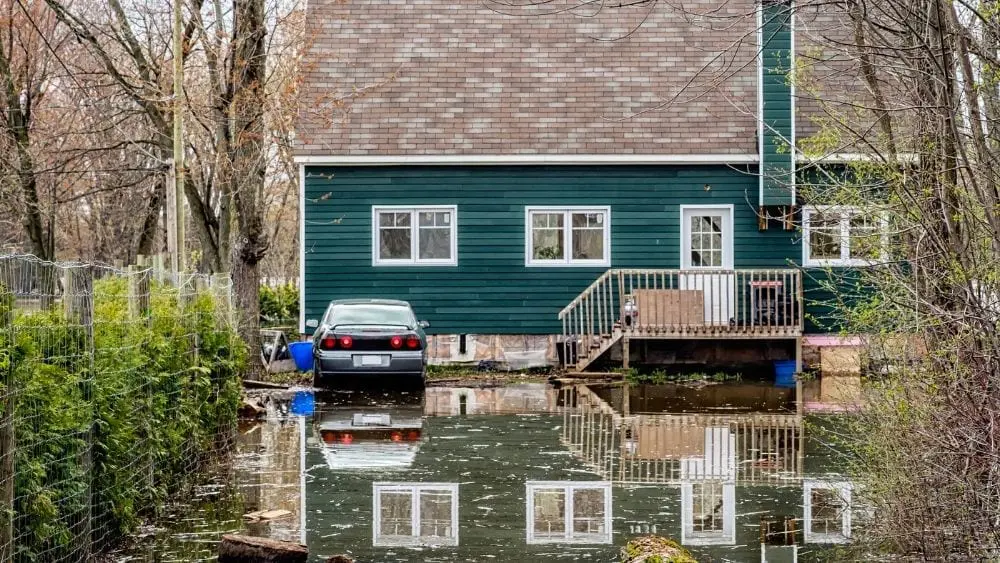Flooding is categorized as the No. 1 naturaldisaster in the United States, affecting every state. It can devastate entirecommunities, destroying neighborhoods, displacing families and forcingresidents to pick up the pieces in Mother Nature’s wake. It’s no wonder that homeownersquestion whether flood damage is included in their home insurance policy.
Everyone lives in an area susceptible toflooding. While we may think coastal states, such as Louisiana, Florida andCalifornia, are at the greatest risk of floods because of tropical storms andhurricanes, the Federal Emergency Management Agency says that more than 20 percentof all flood claims come from properties outside of high-risk flood zones. Floodingcan occur from heavy rains, melting snow, inadequate drainage systems andfailed protective devices like dams. And just one inch of water can cause$25,000 worth of damage to your home.
With this risk in mind, here are 10 key thingsevery homeowner needs to know about flood insurance.
1. Standard Home Insurance Policies Don’t Cover Flooding
While water damage, such as that from a frozenpipe, is typically included in your standard home insurance policy, thisdoesn’t extend to flooding. Flooding coverage isn’t included in the majority of,if not all, conventional home owners insurance policies and needs to bepurchased separately.
In some cases, depending on where you live andif your area is categorized as high-risk, your mortgage lender may require youto buy flood insurance as a mandatory measure. Your lender doesn’t want you tolose track of mortgage payments if you’re forced to empty your bank account tocover major repairs from a flood.
And according to FEMA, under federal law,flood insurance also is a must for any federal financial assistance to build inany areas classified as special flood hazard areas.
2. The Federal Government Provides Flood Insurance
The federal government provides flood insurance via the National Flood Insurance Program (NFIP), which is run by FEMA. While flood insurance is underwritten and issued by the government, policies are sold through private insurance agents who act as a liaison between the NFIP and the homeowner. Keep in mind, not all insurance companies offer NFIP insurance, but FEMA provides a list to help you get started.
You can check if your area participates in the NFIP on FEMA’s FloodSmart.gov website, which includes a NFIP Community Status Book, listing flooding risk status reports by state and territory.
As long as your community is listed in one ofthe 21,000 or so regions covered in the NFIP, you’re eligible for two types ofcoverage — building property and personal (contents) property. And yes, it’swise to secure both types.
3. What the NFIP Covers
Building property coverage is like dwellinginsurance in a standard home policy, covering the physical structure of yourhome and its foundation, from electrical and plumbing to furnaces, waterheaters and any built-in kitchen appliances.
Building property coverage insures you at yourhome’s replacement cost value, not its market value, for up to $250,000. Shouldflooding leave its mark on your home, this insurance will trigger and cover anyrepairs up to the maximum amount you’re insured for.
Contents insurance comes separately, just likein a standard home policy. It covers the inventory of your personal propertyfor up to $100,000, but factors in depreciation value. If you sunk $5,000 intoyour home entertainment system 10 years ago and the system is destroyed in aflood, your policy would pay you for what your tech would be worth today toreplace. Your clothes, furniture and everyday possessions are accounted for incontents insurance.
Flood insurance even provides $2,500 ofcoverage for valuables like jewelry, furs and artwork.
4. Private Flood Insurance Is Available, Too
Some — but not many — insurance companiesoffer private flood insurance, or excess flood protection, that isn’t backed bythe government and NFIP. It’s an avenue worth exploring if you need to top off yourpolicy with private insurance (for example, if you’re in a high-risk area andyour home is worth more than $250,000). Combining both policies could protectyou if the cost of repairs exceeds what’s covered in your NFIP policy so youaren’t stranded and paying out of pocket for the difference.
There is a handful of other great featuresthat make private insurance useful, including extended coverage on yourdwellings and contents insurance, faster activation (sometimes as quickly aswithin a week) and covering costs for short-term housing if you’re forced torelocate. Private insurers also tend to process and file your claims faster.
Do your homework and some number crunching tosee if you need private insurance, and pull together some quotes from privateinsurers. Depending on where you live, some private insurance will be backed bythe state through a guaranty fund. This is an extra layer of protection: If yourinsurer closes shop, your state will pay the coverage promised to you.
The downside? Private flood insurance comes ata much heftier cost than the NFIP, especially if you live in a high-risk area.In some cases, some insurers won’t even cover certain regions due to the risk.
5. What Flood Insurance Does Not Include
Every policy comes with its fine print andthis applies to flood insurance too. Any damage caused by moisture, mildew ormold that could have been avoided by the property owner or which is notattributed to the flood won’t be covered by your flood insurance.
Damage caused by earth movement, even if theearth movement is caused by flooding, is also exempt.
Additional living expenses, such as temporaryhousing, while your repairs are being made will come out of your own pocketunder the standard NFIP policy, along with any property and belongings outsideof your insured building. This includes your deck, patio, fencing, seawalls,hot tubs and swimming pools. It’s in these instances that extra insurance maybe worthwhile for some households.
6. What Flood Insurance Costs
Just like your conventional home insurancepolicy, multiple factors are at play in calculating the cost of your flooding policy.In this case, it includes your location and flood zone risk; the design, ageand type of structure of your home; and the amount and type of coverage you’rebuying.
Homes categorized as high-risk will commandmore expensive policies — to the tune of about five times compared to regionsclassified as low-risk. The government suggests that in high-risk areas, there is at least a one-in-four chance of floodingduring a 30-year mortgage.
And then there are factors like yourdeductible — a higher deductible will lower the premium you pay.
Simple upgrades around the home, such as installingflood boards and air brick covers to keep water out of the home, could reduceyour risk and your insurance costs.
You can also consider wet floodproofing byconstructing or rebuilding the part of your home within base flood elevation withmaterials that are resistant to floodwaters. Dry floodproofing includes usingfloodproof sealants and barriers, and adding a drainage system to divert wateraway from the house.
7. Calculate Your Flood Risk
Misconceptions abound when it comes toassessing flood risk. It’s not just homes in low-lying or coastal areas thatare at risk; homes on hills or inclines can be susceptible to flooding andinland states are also vulnerable. Floodinsurance can pay regardless of whether there is a major hurricane thatwarrants a presidential disaster declaration.
Flood history, rainfall, snowfall, topography,wind velocity, tidal surge, flood control measures — these are all key factorsused by FEMA to measure flood risk.
The government notes that residents living inand around areas affected by wildfires face an increased risk of flooding for several years post-wildfire. Flood Smart.govrecommends that residents living in the western United States purchase flood insurance to protect againstdevastating flooding and the mudflows that can follow.
You can checkwhere your neighborhood falls on the threshold as a flood zone — low-,moderate- or high-risk — via the NFIP’s Flood Insurance Rate Map (FIRM).
The map outlines a community’s base floodelevations, flood zones and floodplain boundaries. Have a close look at theFIRM — or DFIRM, its digital version — to get a reliable indication of whatflood zone you’re in. Make sure to make this an annual habit because these mapsare constantly updated to match changes in geography, construction, weather andflood management activity.
Have a look at FEMA’s Flood Map ServiceCenter and check your risk by putting in your address.
8. Wind-Driven Rain Is a Different Story, Though
Every insurance policy comes with a unique setof caveats and exclusions. In this case, it’s wind-driven rain damage. FloodSmart.govnotes that when rain enters through a wind-damaged window or door, or seeps inthrough a hole in the wall or a roof, the NFIP considers the resulting water damageto be windstorm-related and not flood-related.
Things get pretty technical here — FloodSmart.govsays that flood insurance covers “overflow of inland or tidal waters andunusual and rapid accumulation or runoff of surface waters from any source.”But the flood must inundate two or more acres of normally dry land area or twoor more properties (one of them should be yours).
Flood insurance includes flood damage causedby hurricanes, rivers and tidal waters as long as the floodwaters covers twoacres or two properties, but once wind and hail get involved, it’s your initialhomeowners insurance policy that’s put to work.
What caused the flood is important too. Forexample, damage caused by a sewer backup is only covered by flood insurance ifit’s a result of flooding — damage isn’t covered if the sewer backup andsubsequent flooding is caused by some other issue.
9. Don’t Take Your Time — It Takes 30 Days to Kick In
Some homeowners may hold off on buying a floodinsurance policy, waiting for a rainy day — literally. This isn’t a cleverstrategy to deploy, though, as in most instances, homeowners face a 30-daywaiting period before their policy goes into effect.
Instead of waiting until the rainy seasonapproaches to add a flood insurance policy, your safest bet is to do yourresearch and secure your policy while conditions are dry. This way, it’savailable to you and there is no debate about when your policy kicks in if youneed to make a claim.
10. Flood Insurance Has Paid Out a lot of Claims
FEMA notes that as of September 2019, 59insurance companies participated in issuing NFIP policies. As of August 2019,69 percent of policies covered single-family homes, 20 percent coveredcondominiums and 5 percent covered businesses and non-residential properties.
Hurricane Katrina in 2005 still held thehighest number of NFIP payouts, as of March 2019, totalling at $16.3 billion. HurricaneHarvey in 2017 ranked second, leading to $8.9 billion in NFIP payouts, followedby Superstorm Sandy, in 2012, which resulted in $8.8 billion in payouts fordamages.
The average flood insuranceclaim payment over the past five years has been about $69,000, according to FloodSmart.gov.
If you don’t have floodinsurance, the government can step in with federal disaster assistance but onlywhen there is a presidential disaster declaration — and most flood events don’tculminate with this step.
Federal disaster aid istypically a no-interest or low-interest disaster loan that must be repaid, leavingyou on the hook for the entire cost of your home’s repair post-flooding. Theseloans usually aren’t more than $5,000 to $10,000, leaving you with very littlefinancial wiggle room to sort out repairs and a rebuild.
So, when it comes to protecting your home fromflooding, particularly if you live in a high-risk area, it might be wise togive some serious thought to a flood insurance policy to give yourself somepeace of mind and to potentially save your pocketbook.

Carmen Chai is an award-winning Canadian journalist who has lived and reported from major cities such as Vancouver, Toronto, London and Paris. For NewHomeSource, Carmen covers a variety of topics, including insurance, mortgages, and more.

 Questions when Touring Master Planned Communities
Questions when Touring Master Planned Communities